By Glenn VK4DU
At the start of WW2 in September 1939, all UK (and Australian) amateur licences were suspended for the duration of hostilities. This was obviously done for security reasons, but it also allowed the use of valuable amateur radio spectrum by the military.
In 1943, the British engineer Barnes Wallis devised a revolutionary weapon to be used against the great dams of the Ruhr Valley in Germany.
A cylindrical mine/bomb was to be dropped by a Lancaster bomber flying at 60 feet above the dam reservoir, at a precise distance from the dam wall. The bomb would bounce along the surface of the reservoir, strike the dam wall, and sink alongside.
At a pre-set depth, the bomb would detonate, using a combination of explosive force and water pressure to break the dam wall.
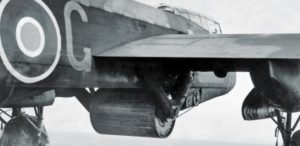
The bouncing bomb – all 4 tons of it…
A new, elite Royal Air Force (RAF) squadron; 617, was formed to deliver the weapon. The squadron was commanded by Wing Commander Guy Gibson.
This was, of course, the famous Dambusters.
Today marks the 75th anniversary of the Dambusters raid, carried out on 16/17th May 1943.
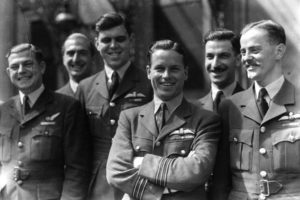
Guy Gibson, centre. His fellow Dambuster pilot, Australian Micky Martin is at right.
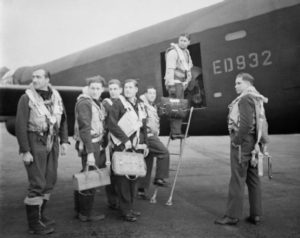
In this famous picture, Gibson and his crew board ‘G for George’ before the raid. Radio Operator Flt Lt Bob Hutchinson has one foot on the ladder below Gibson.
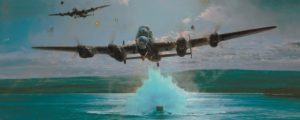
Delivering the weapon
With Guy Gibson’s Lancaster flying above to attract anti-aircraft fire, Henry “Dinghy” Young drops his “Upkeep” mine on the Möhne dam, in Robert Taylor’s painting
Dambusters—The Impossible Mission.
The Dambuster mission, Operation Chastise, differed from normal bomber operations in that the target list was variable and depended upon which dams were breached.
Accordingly, a high level of command and control was required from RAF 5 Group Headquarters, located at Grantham, Lincolnshire (north of London).
The 19 Lancaster bombers were fitted with VHF AM radiotelephone equipment to enable direct pilot-pilot communications. However, the link with the UK was provided by HF W/T (morse), sent and received by each aircraft’s Radio Operator.
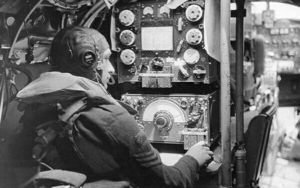
Lancaster Radio Operator at his key. 70W transmitter at top, receiver at bottom.
The Antenna was a wire strung between the fuselage and the left hand rudder.
A complex system of codewords was developed for the raid. A release of Upkeep (the bomb) would be signalled by the prefix Goner followed by a number indicating what had happened after the release of the weapon:
| Goner 1 | failed to explode |
| Goner 2 | overshot dam |
| Goner 3 | exploded more than 100 yards from dam |
| Goner 4 | exploded 100 yards from dam |
| Goner 5 | exploded 50 yards from dam |
| Goner 6 | exploded 5 yards from dam |
| Goner 7 | exploded on contact with dam |
| Goner 8 | no breach made |
| Goner 9 | small breach made in dam |
| Goner 10 | large breach made in dam |
After Goner and the appropriate number, a letter was added to signify which dam had been attacked:
A = Mohne
B = Eder
C = Sorpe
D = Lister
E = Ennepe
F = Diemel
For example, a message Goner 79A would mean: weapon released at the Mohne Dam, exploded on contact with the dam and caused a small breach.
There was also a series of individual codewords to indicate which dam had been breached and the actions to follow. Amongst these were:
NIGGER: Mohne Dam breached, proceed to the Eder Dam.
DINGHY: Eder Dam breached, proceed to the Sorpe Dam
MASON: All aircraft return to base.
Nigger was the name of Gibson’s beloved black Labrador dog, run over and killed just before the raid. Dinghy was the nickname of Gibson’s second in command, Squadron Leader Young, who delivered his bomb perfectly on the dam, but was tragically shot down and killed, along with all his crew, on the return leg.
The codewords were depicted being received from the aircraft at Grantham HQ in the famous 1950s film The Dambusters….and, unusually, the morse was 100% accurate…
It took 5 bombs to breach the Mohne Dam. One aircraft was shot down over the dam and crashed in the field below. Miraculously, two of the crew bailed out at about 300 feet and survived.
When the last bomb was successful, there was much whooping and hollering over the VHF R/T radios as the pilots celebrated. Everyone was looking at the 1000 foot plume of water cascading over the dam wall….everyone apart from Gibson’s radio operator, Flight Lieutenant Bob Hutchinson DFC, who was bent over his key, sending the famous nigger codeword back to Grantham.
And the frequency he used? 3680 kHz in our 80m band.
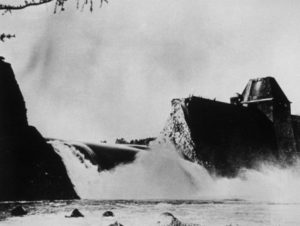
The raid was a success – two dams were breached…..but it was very costly – 8 of the 19 Lancasters and 53 aircrew did not return.
Gibson was awarded the Victoria Cross for his inspired leadership, making him the most decorated pilot in the Royal Air Force at the time (VC, DSO and Bar, DFC and Bar).
Hutchinson was awarded a bar to his Distinguished Flying Cross.
Australian pilot Micky Martin was awarded the Distinguished Service Order.
Sadly, Gibson and his crew did not survive the war. Gibson’s crew were killed later in 1943 flying with another pilot, and Gibson was killed leading a bombing raid in 1944.
Micky Martin survived the war. He remained in the RAF and retired as an Air Marshal (Airforce equivalent to an Army General or Navy Admiral) in the 70s.
73
Codewords from www.thedambusters.org.uk
Pictures courtesy the imperial War Museum
Painting as noted.